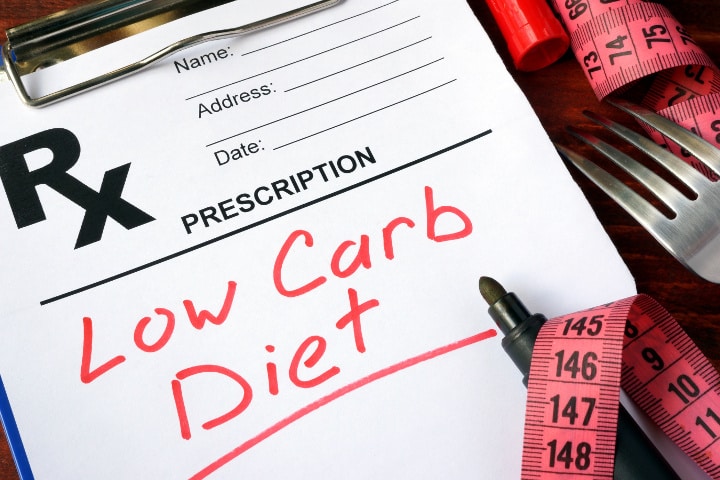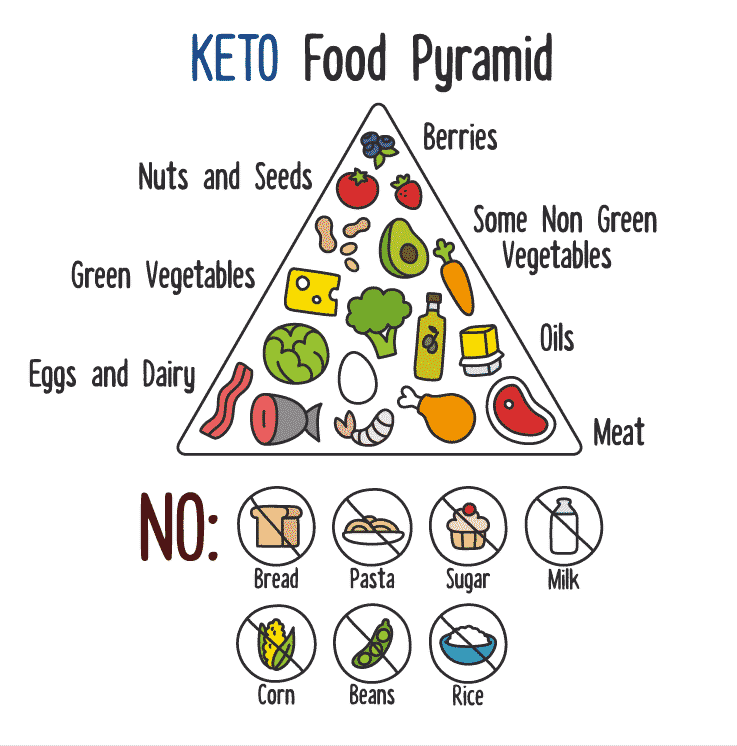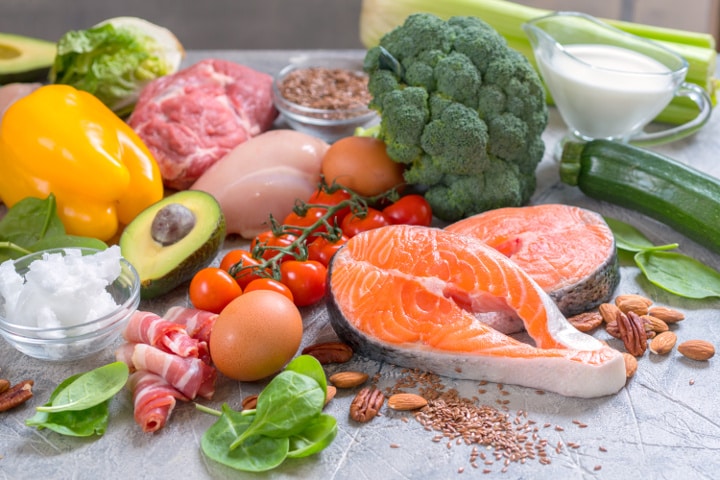LCHF Diet: Everything You Need to Know About Going Keto
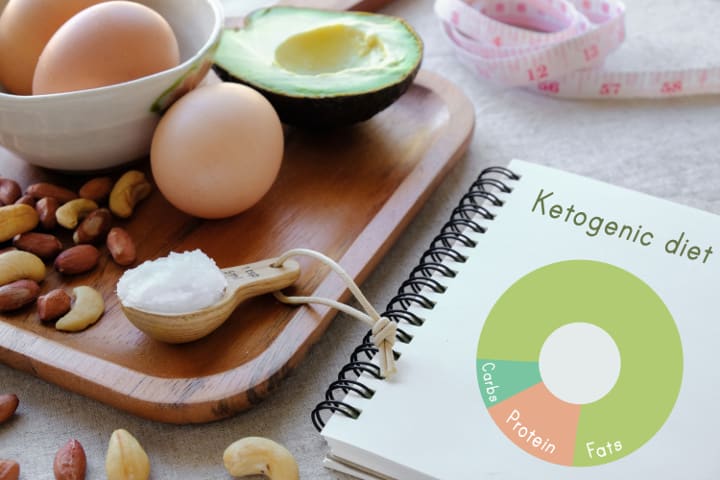
We’ve all experienced the ups and downs of dieting. Even when we find a diet that works, it’s just so hard to keep the weight off.
What most of us are really looking for is more than just a diet: we need sustainable change that can become part of a new, healthier lifestyle.
With the Low Carb High Fat (LCHF) Diet—often referred to as the ketogenic (or keto) diet — people everywhere are making lasting changes that promote weight loss, greater athletic performance, and improved health.
Unfortunately, there are a lot of myths surrounding carbs and fats. Most of us have spent our entire lives believing that we need more carbs in our diet and fewer calories from fat. And, it can be hard to accept that eating more fat is actually the key to sustainable weight loss, improved fitness, and greater health benefits.
In this article, you’ll find everything you need to know about going low carb, high fat — from what it is and how it works to keto-friendly recipes and meal plans you can use to get started.
Ch 1: What Is Ketosis & How Does a Low Carb High Fat Diet Work?
Ch 2: What’s the Difference Between a Low Carb Diet and a Ketogenic Diet?
Ch 3: The Benefits of a Low Carb High Fat Diet
Ch 4: How Can Eating More Fat Help You Lose Weight?
Ch 5: What Does It Mean to Be “Fat-Adapted”?
Ch 6: Signs You’re in Ketosis
Ch 7: How Low Should Your Carbs Go?
Ch 8: How to Track Macros on a Ketogenic Diet
Ch 9: What Can You Eat on a Keto/LCHF Diet?
Ch 10: Surprising Keto-Friendly Alternatives
Ch 11: LCHF/Keto Recipes
Ch 12: 1-Week LCHF/Keto Diet Plan
Ch 13: Side Effects of Keto
Ch 14: Keto FAQs
Ch 15: Tips to Get the Most Out of Keto
What Is Ketosis & How Does a Low Carb High Fat Diet Work?
The ketogenic or LCHF diet is all about getting your body keto-adapted.
What does that mean?
Your body’s default energy source is glucose — one of the sugars you get when your body breaks down carbohydrates. When you eat foods high in carbs (and even protein through a process called gluconeogenesis), your blood glucose level increases. This triggers an insulin response so your blood sugar stays within the range your body needs to function.
Insulin is responsible for storing fat in our body. It also interferes with our body’s ability to access energy from stored fat, which can make it especially hard to lose weight. The carbohydrates that we find in some of the most common foods result in more insulin, which leads to the accumulation of fat when we don’t burn enough calories.
But, wait a minute. Aren’t carbohydrates good for us?
Many of us have grown up not just believing, but knowing that carbohydrates were the key to staying healthy and fit. We heard it in the classroom and saw it from marathoners and other athletes who would “carbo-load” before an event or competition.
Certainly our bodies can function with carbs as the primary source of calories, but there are a few drawbacks we don’t often hear about from other sources.
We need to eat carbs more often.
Carb cravings are one way our body tells us we need more calories. Studies suggest that a drop in blood sugar stimulates hunger. And as a quick source of energy, it’s natural to turn to high carb foods when we’re hungry. But, just as fast as we gain energy from carbs, we burn through it. And a few short hours after indulging our hunger with carbohydrates — especially from foods high in processed sugars — it’s off to the fridge again.
In the long-term, our bodies are only designed to store enough carbohydrates to last one or two days, but we have multiple weeks of fat stores.
We need to eat more carbs.
Carbohydrates provide an average 4 calories per gram, compared to 9 calories per gram of fat. So, not only do we need to eat carbs more often, but we need to eat more of them just to stay active. And, as we already mentioned, carb cravings can return in just a few hours.
Our bodies crave carbs even when we aren’t hungry.
In addition to craving carbs when we’re hungry or low on blood sugar, research has linked carb cravings to increased serotonin levels. Serotonin is a chemical in the brain associated with reduced stress and that helps us feel less stressed and more relaxed. But, turning to high carb foods as a way to manage stress and emotions can lead to spikes in blood sugar, weight gain, and a variety of health problems.
Despite what we now know about carbs, however, we’re still told that a majority of our energy should come from carbohydrates. The Institute of Medicine’s Dietary Reference Intake recommends 45–65 percent of an individual’s daily caloric intake, or macronutrients, come from carbohydrates, 20–35 percent from fat, and 10–35 percent from protein. And according to the CDC, the average person is right in line with the DRI recommendations, getting about 50 percent of their calories from carbohydrates, 34 percent from fat, and the remaining 16 percent from protein.
The ketogenic diet flips that split on its head, lowering energy from carbs to just 10 percent and increasing fat intake to 70 percent or more in order to help your body reach ketosis.
Ketosis is when your body shifts metabolism away from glucose and toward fat utilization. Burning fat produces energy molecules called ketones, an efficient energy source your body can use in the absence of glucose.
Ketosis is a natural state for your body to be in, and the health benefits extend well beyond weight loss and greater physical fitness.
The fastest way to reach ketosis is by fasting, but that isn’t sustainable (or fun). A ketogenic diet is a sustainable and satisfying way to become keto-adapted. When you become keto-adapted, your body has learned to stop relying on glucose and start relying on ketones from fat.
And unlike many other diets, a keto diet can be eaten indefinitely.
What’s the Difference Between a Low Carb Diet and a Ketogenic or Low Carb High Fat Diet?
Low carb isn’t the same thing as eating low carb, high fat. And, a low carb diet doesn’t mean you are in ketosis.
There are three general types of low carb diets, but only one is ketogenic.
1. Unguided Low Carb
Many people hear about the benefits of a low carb diet and immediately start eating less bread, pasta, and other foods high in fiber, starches, and sugars. And yes, eating fewer carbs — even if you’re only making a small change once or twice a week — can be helpful.
But without a plan for how to replace those calories and maintain energy levels throughout the day, a low carb diet won’t deliver sustainable, consistent results.
To get the most out of any low carb diet, you need to know where you’ll make up lost calories and how that will affect your body.
2. Low Carb, High Protein
For quick and sustainable carb-cutting, many people turn to high-protein foods like quinoa, fish, and baked chicken. Not only are foods high in protein filling and flavorful, but they’re traditionally healthy, which means we don’t have to feel guilty if we go back for seconds.
But, one of the reasons protein works so well as a replacement for carbs is that in many ways, that’s all it is. Just like carbs, protein provides an average 4 calories per gram. That means you’ll have to eat just as much. And because eating protein can increase blood sugar levels (just like carbs) through a process known as gluconeogenesis, the body still produces more insulin, making it harder to lose weight.
So, while a low carb, high protein diet works well for many athletes trying to build muscle mass, it can be harder to utilize if your goal is to lose weight, especially if you exercise less frequently than is recommended.
Depending on your dietary needs and goals, you may see more noticeable and sustainable results by turning to fat, instead of protein, as a carb replacement.
3. Low Carb, High Fat (Ketogenic Diet)
When you replace most of the calories you used to get from carbs with dietary fat — and keep protein intake even — you’re on a true Low Carb High Fat (LCHF) diet, or ketogenic diet.
The LCHF diet has been linked to greater weight loss, more energy, improved focus, and other health benefits. But, because the keto diet requires much higher fat consumption, it can be hard to accept that it really does work as a sustainable way to lose weight and get fit.
The rest of this article focuses on a true LCHF, ketogenic diet.
The Benefits of a Low Carb High Fat Diet
People everywhere are turning to the LCHF diet for more than just weight loss. Somewhat ironically, the long list of benefits from eating low carb, high fat is actually one of the reasons some people remain skeptical. At a glance, the ketogenic diet seems a little too good to be true.
That isn’t to say there aren’t drawbacks to eating keto (we’ll get into those later in this article). But the benefits are so significant that it’s natural to question the claims. After all, fad diets come and go every year, and they all promise better health and a slimmer stomach.
So, let’s take some time to explore the benefits attributed to a ketogenic diet and the science, studies, and success stories that support each point.
The 3 Main Benefits of LCHF
Satiety. One of the hardest parts about any diet is feeling starved or deprived. Even if you don’t feel hungry, many diets make it so hard to feel full!
Protein and fat are more satiating than carbs, meaning you’ll feel full faster and longer. And fat has an incredible 9 calories per gram on average — more than double the calories in a gram of protein or carbohydrates.
Ok, so fat has more calories. Won’t that make it easier to overeat?
Studies have actually shown that high fat diets make it easier to control calories without having to worry over portion sizes.
In randomized, controlled trials like this one published in the Journal of Clinical Endocrinology & Metabolism, one group is placed on a calorie-restricted diet while the other is placed on a non-restricted low carb diet. And time and again (in every study we looked at!), the low carb group that could fill up on fat and protein lost more weight than the group on a calorie restricted diet.
- Foster GD, et al. A randomized trial of a low-carbohydrate diet for obesity. New England Journal of Medicine, 2003.
- Samaha FF, et al. A low-carbohydrate as compared with a low-fat diet in severe obesity. New England Journal of Medicine, 2003.
- Yancy WS Jr, et al. A low-carbohydrate, ketogenic diet versus a low-fat diet to treat obesity and hyperlipidemia. Annals of Internal Medicine, 2004.
- Nickols-Richardson SM, et al. Perceived hunger is lower and weight loss is greater in overweight premenopausal women consuming a low-carbohydrate/high-protein vs high-carbohydrate/low-fat diet. Journal of the American Dietetic Association, 2005.
- McClernon FJ, et al. The effects of a low-carbohydrate ketogenic diet and a low-fat diet on mood, hunger, and other self-reported symptoms. Obesity (Silver Spring), 2007.
- Dyson PA, et al. A low-carbohydrate diet is more effective in reducing body weight than healthy eating in both diabetic and non-diabetic subjects. Diabetic Medicine, 2007.
- Westman EC, et al. The effect of a low-carbohydrate, ketogenic diet versus a low-glycemic index diet on glycemic control in type 2 diabetes mellitus. Nutrition & Metabolism (London), 2008.
- Krebs NF, et al. Efficacy and safety of a high protein, low carbohydrate diet for weight loss in severely obese adolescents. Journal of Pediatrics, 2010.
People who can eat as much fat as they want are consistently losing more weight than calorie-restricted, low fat dieters.
That’s incredible!
And it’s because it’s easier to feel satiated, or full and satisfied, on a high fat diet. You just stop eating when you’re full, and you naturally consume fewer calories.
Getting calories from fat (and protein to a lesser degree) can also reduce cravings by lowering insulin levels. When you eat carbs — especially processed carbs — it raises your blood sugar, causing a spike in the production of insulin. As insulin rises, it can cause you to crave more carbs, and this carb-craving cycle can make it hard to feel satisfied on many diets.
By shifting to a high fat diet, you can feel full and satisfied without having to count calories. Knowing when you’re full on the LCHF diet is like waking up to the sunrise instead of an alarm clock — it’s natural.
 Fat Loss. The keto diet is all about burning fat for energy, and this supports weight loss in two ways. The first is pretty obvious: if you’re burning more fat, you’re losing more fat.
Fat Loss. The keto diet is all about burning fat for energy, and this supports weight loss in two ways. The first is pretty obvious: if you’re burning more fat, you’re losing more fat.
It’s common to assume the extra fat you eat on a keto diet will counter any extra fat burning your body does. But, as we saw in the last section, fat is more satiating than carbs, so you’re better able to stop eating when you’re full on a LCHF diet. In fact, low-carb dieters lost almost twice as much weight on average than people on a calorie-restricted diet.
When you reduce carbohydrates from 50 percent of your macros to less than 10 percent, you’re doing more than teaching your body to burn fat for fuel. You’re cutting many of the sugary foods that are so hard to stop eating, lowering extra calories your body will convert to fat.
And because your body is no longer responding to blood sugar spikes from high-carb, high-sugar meals, your insulin levels can even out and drop to healthy levels, making it easier for your body to access stored fat for energy.
Metabolic Advantage. It may seem strange that you can lose more weight on a diet while eating the exact same number of calories. But that’s what happens on a ketogenic diet. By teaching your body to burn fat as an energy source, you gain metabolic flexibility that allows your body to work more efficiently and maintain a higher, steadier level of energy.
While there is some disagreement about whether a Low Carb High Fat diet or a standard low carb diet offers greater metabolic advantage, studies have consistently shown that reducing carb intake allows individuals to lose more weight without having to cut total calories.
And, there is evidence that ketosis can increase endurance and aerobic capacity.
This has clear benefits for athletes, trainers, nutritionists, and other professionals who rely on getting every ounce of performance from their bodies.
NBA superstar Lebron James famously switched to a low carb diet in 2014, and without such a high profile example of what the diet could do, keto may not have grown into the dietary powerhouse it has become. It wasn’t just that James looked like he was in better shape — slimmer and more toned — but he was playing at full speed deep into the fourth quarter of most games. His energy seemed limitless.
In recent years, more athletes and celebrities have come out in support of the ketogenic diet, fueling the diet’s popularity with pictures, personal interviews, and improved physical performances as proof the LCHF diet worked for them.
Icons from Halle Berry and Melissa McCarthy to Tim McGraw and Kobe Bryant have all had their weight loss, increased fitness, or improved health credited to eating a keto diet. And their reasons can go beyond weight loss and physical fitness.
Other Benefits of LCHF
Physical. In addition to greater weight loss, sustained energy, and increased endurance, the LCHF diet has been linked in some studies to lower blood pressure, lower insulin levels, a calmer stomach, and even less acne.
Mental. Keto has been shown to support better focus, lower stress, increased cognition, reduced food cravings, and less severe ADHD symptoms.
Medical. A growing number of studies have focused on individuals with diabetes, metabolic syndrome, and other health problems, and the results have been promising. The diet’s ability to lower insulin levels can reduce or even eliminate the need for diabetes medication in some instances. And, many doctors recommend a ketogenic diet as a way to reduce or prevent seizures in people with epilepsy who aren’t responding to medication.
When Should You Seek a Second Opinion?
As with any major dietary change, we recommend consulting with your primary care physician, doctor, and nutritionist before starting a ketogenic diet.
And you should always visit your doctor before going keto if you fit one of the following conditions:
You’re on medication for diabetes. Diabetes medication helps control blood sugar and insulin levels. When you start a ketogenic diet, blood sugar and insulin levels may drop, which could bring your blood sugar too low if your diabetes medication or dosage doesn’t change.
You’re on medication for high blood pressure. The LCHF diet can affect your blood pressure as well as cause fluctuations in water and mineral levels that could reduce the effectiveness of current blood pressure medication. Talk with your primary care physician before starting a keto diet so they can properly monitor blood pressure and adjust medication as needed.
You’re breastfeeding. Starting a ketogenic diet takes time, and it can cause all kinds of changes in your body and brain as you become keto-adapted. When you’re first going into ketosis, your body and brain respond as if you were starving — even though you know you’re getting enough calories. Not only will this change the chemicals and hormones in your body, but sticking to a keto diet could actually cause you to lose weight faster than is recommended when nursing.
You’re experiencing adrenal fatigue. People with adrenal fatigue tend to gain weight easily and have trouble losing weight. While cutting carbs has been shown to support weight loss, people with adrenal fatigue should generally avoid lowering their carb intake until their adrenals have recovered.
With any new diet, it’s important to know your weight loss or fitness goals and talk to your doctor or physician. In some cases, you may need to add certain foods or supplements to get the most out of the change. Other times, you may benefit from a different diet entirely.
In order to be successful on a ketogenic diet, you need to eat high fat. But, dietary fat even has the word fat in it… how can eating more of it possibly help us lose weight?
How Can Eating More Fat Help You Lose Weight?
Dietary fat gets a bad rap. It’s been blamed for obesity, heart problems, weight loss challenges, and everything in between. As we know, the causes of weight gain and associated health problems are much more complicated than the intake of dietary fat alone.
Mark Hyman, MD, (Eat Fat, Get Thin) does a nice job summarizing many of the benefits of eating a low carb, high fat diet in his video Why Fat Doesn’t Make You Fat.
Source: https://youtu.be/sqOK3AX4RLA
Studies have shown that eating a low carb diet can drive significantly more weight loss than a low fat diet. In fact, eating too little fat can actually make it harder to lose weight.
Eating Fat Speeds Up Metabolism and Burns More Calories
Not all calories are the same. And, calories from carbs or proteins won’t interact with your body the same way as calories from fat. That’s why many low fat diets fail to deliver results: the focus is on cutting calories without enough emphasis on which calories to reduce.
In a 2012 study published in the Journal of the American Medical Association (JAMA), individuals on a low carb diet (60% fat, 30% protein, 10% carbs) burned over 300 more calories per day than those on a low fat diet (60% carbs, 20% protein, 20% fat) when eating the same number of total calories.
In a review of 23 studies comparing low carb and low fat diets, Healthline found only one that showed greater weight loss from a low fat diet.
The reasons eating more fat can actually help you lose weight have to do with how the body burns calories and why we crave carbs in the first place.
The simplest carbohydrate is glucose, a sweet-tasting sugar. Fructose, another carbohydrate, is what gives fruits their sweet or tart flavors. These simple sugars (monosaccharides) are absorbed into the bloodstream much faster than fat, protein, and complex carbohydrates like the starch and fiber found in many plants.
So if we need a quick burst of energy or we just want to eat something sweet, chances are we’re reaching for a food high in carbs.
While the body can burn glucose and glycogen more quickly than fat, that isn’t always a good thing. And, relying too heavily on carbohydrates could actually slow down your metabolism. Instead of burning fat for fuel throughout the day, you’re essentially training your body to wait for the next high-carb meal.
When you shift macronutrients away from carbs and toward fat with a ketogenic diet, your body learns to use fat as a primary fuel source.
Burning fat for fuel will naturally reduce your body’s fat stores and help you look leaner. And because the average gram of fat contains 9 calories (compared to just 4 calories per gram of carbohydrates), you’re tapping into a concentrated and long-lasting source of energy that can keep you motivated and satisfied all day long.
Fat Is More Filling
One reason low fat diets are so popular is that you can eat twice as many carbs as fat without increasing total calories. For the same reason, eating more dietary fat means you can get the calories you need and feel full and satisfied without having to eat as much or as often.
Fat Can Reduce Carb Cravings
When you eat foods high in carbs, your blood sugar spikes. The body responds with a wave of insulin to get blood glucose levels back down. These rapid ups and downs can increase insulin resistance and throw your metabolism out of sync. And when your body doesn’t know what blood sugar and insulin levels are normal, carb cravings can be hard to predict and even harder to manage.
By shifting most of the calories in meals and snacks from high-sugar carbs to healthy fats, the body’s blood sugar and insulin levels can start to even out. And, because feelings of hunger are associated with insulin levels, reducing carbs make you feel less hungry and more satisfied between meals.
And, the benefits of a low carb, high fat diet extend beyond weight loss.
Eating More Fat Can Improve a Variety of Health Markers
Studies conducted over the past 20 years have given us data on many key health markers associated with risk of disease, from cholesterol, and triglycerides to blood pressure and blood sugar levels.
Low carb, high fat diets raised the level of good HDL cholesterol in 18 of 23 studies. HDL cholesterol is associated with metabolic health and lower risk of cardiovascular disease. What’s even more exciting, none of the studies showed a significant increase in total cholesterol or harmful LDL cholesterol. So, a LCHF diet can raise good cholesterol without increasing the bad.
LCHF also lowered triglycerides, a risk factor for heart disease, in 19 of 23 studies. After a snack or meal, the calories you don’t use are converted to triglycerides and stored in fat cells as a source of energy your body can use when there aren’t enough carbs. Triglycerides are the body’s leftovers, and they can quickly start to build up if you regularly eat more calories than you burn.
In a 2008 study out of Duke University Medical Center’s Department of Medicine, patients with obesity and type 2 diabetes were placed on either a low carb, ketogenic diet or a low glycemic, calorie-restricted diet. After 24 weeks, 95 percent of the individuals on the ketogenic diet were able to safely reduce or eliminate diabetes medication (compared to 62 percent of individuals in the calorie-restricted group).
Clearly eating more fat can be a good thing. But are all fats good for you on a Low Carb High Fat diet? And what happens to your body when you become fat-adapted and how to know when you’re in ketosis.
What Fat Is Good Fat on a Low Carb High Fat Diet?
While eating more fat is an essential part of a ketogenic diet, not all dietary fat is the same, and knowing the difference can help you get the most out of every calorie.
First, there are four types of fat to be aware of.
Saturated fats are fine on a keto diet. These are the fats you find in butter, coconut oil, whole milk, and red meat. You may have heard that all saturated fats are bad for you, or that high levels of saturated fat have been linked to increases in LDL cholesterol, but that isn’t always the case, according to Dr. Mark Hyman.
“There is a huge difference between quality saturated fat in coconut oil or MCT oils, as compared with what you get in a fast food cheeseburger. Lumping them all together becomes like putting cauliflower and a cupcake under the carbohydrate category.”
Instead of viewing all saturated fats the same, consider the different sources of saturated fat. When you get saturated fat from healthy sources, like coconuts and grass-fed beef, this actually results in healthier cholesterol that isn’t associated with increased risk of heart disease.
Monounsaturated fats are great on a keto diet. You can get monounsaturated fats from olive oil, avocados, and many nuts and nut oils. Monounsaturated fats are a great way to replace or supplement saturated fat without raising harmful cholesterol.
Naturally occurring polyunsaturated fats that you find in animal protein and fatty fish are great for you, and your keto menu should be full of them. Processed polyunsaturated fats, on the other hand, are not good for you, despite the “heart healthy” label you might find on some labels.
Trans fats should be avoided! They’re a byproduct of the process that turns healthy oils into solids with longer shelf lives, and they’ve been linked to a variety of health problems, including high cholesterol, heart disease, stroke, diabetes, and other chronic conditions. Thankfully, trans fats are becoming less and less common in the food supply.
You’ll also need to keep an eye on your omega-3 and omega-6 essential fatty acids. Eating fish or taking a fish oil supplement can keep your omega 3s balanced. And, nuts and seeds are a great source of omega-6s.
Don’t worry, we’ll get into specific foods you can eat to increase fat intake later in the article.
What Does It Mean to Be “Fat-Adapted”?
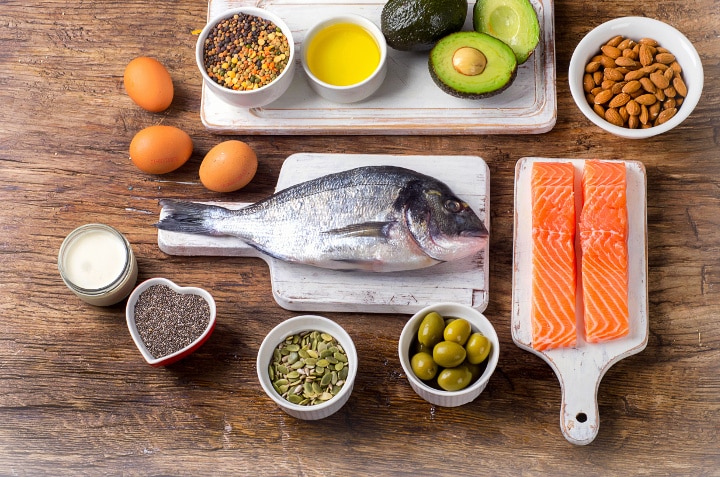 Burning fat produces ketones (the actual source of energy), and you’ll hear many professionals use “fat-adapted” and “keto-adapted” interchangeably.
Burning fat produces ketones (the actual source of energy), and you’ll hear many professionals use “fat-adapted” and “keto-adapted” interchangeably.
When you’re fat-adapted, your body can burn fat for fuel just as easily as protein and carbohydrates. And that metabolic flexibility carries a range of small but life-changing benefits.
Skip snacks and go longer between meals without getting hungry. When you’re fat-adapted, your body always has a ready source of concentrated energy. Reduce cravings and feel physically full and satisfied longer.
Crave high-fat foods instead of high-carb snacks. High carb, high sugar, high starch foods are notoriously hard to stop eating, and they often carry huge drop-off in energy a few hours after eating. High fat foods, on the other hand, are filling and help maintain energy throughout the day. When you wake up craving eggs and bacon instead of a bagel, muffin, or Pop Tart, your keto diet is going well.
Maintain more energy throughout the day. When your body is fat-adapted, you aren’t relying on short bursts and small stores of carbs for energy. Even if you skip a snack or meal, you can make it to the next one without feeling too grumpy or exhausted to keep up with your day.
Experience smaller fitness plateaus. Becoming fat-adapted gives your body access to a new source of fuel, and it’s been a game-changer for athletes everywhere. The body can only store about 500 grams (or 2,000 calories) of carbs at any given time. Under a normal, high carb diet, your body has to resort to emergency stores of glycogen for fuel during intense training periods or endurance events.
When you’re fat-adapted, you can retain glycogen stores in the liver and muscles and give your body a reliable, steady source of energy. In this way, many athletes have been able to reduce or even eliminate fitness plateaus.
Of course, becoming fat-adapted won’t happen overnight. The process could take place in the first week, or it may take several weeks before your body is properly fat-adapted.
Here’s a useful video from Healthful Pursuit on how to tell if you’re fat adapted:
Source: https://www.youtube.com/watch?time_continue=42&v=yG8UlpLmnwg
Signs That You’re in Ketosis
Testing Ketones
One of the surest ways to know if you’re in ketosis is to test ketone levels using urine strips, a breath ketone analyzer, or a blood ketone meter.
Urine strips are the cheapest testing option, as well as one of the simplest. Dip a strip in a fresh sample of your urine and in just 15 seconds you’ll know if you’re in ketosis. Like a pH strip, the ketosis urine strip is easy to read, changing color to show how many ketones are present.
Urine strips are affordable and accessible, but they have a few drawbacks. You’ll have to drink the right amount of fluids for a reliable reading. And even then you’ll receive a ketone range rather than a precise ketone level. Finally, the strips may become less reliable as you become more keto-adapted.
A breath ketone analyzer costs more than urine strips while offering an easy-to-use (and reusable) package. Like urine strips, you’ll only see a range of ketones on the actual device (though you can plug in some models to your computer or smartphone for an exact reading).
The test is as simple as they come, and it’s always nice to save money with a reusable ketone test.
Unfortunately, the test results can be inaccurate, particularly if you just ate a lot of carbs.
Blood ketone meters are the most exact, reliable test available for at-home use. They’re also one of the most expensive, averaging $1–2 per test. If you test your ketones two or three times a day, you could end up paying over $150 every month on ketone testing. You’ll also have to prick your finger for a drop of blood every time you want to test using a blood ketone meter.
If you are more concerned with becoming keto-adapted than knowing your exact ketone levels, there are a number of physical signs you can look for to determine if you’re in ketosis.
Physical Signs You’re In Ketosis
Becoming fat-adapted requires your body to change how it burns calories. And, that means you may experience some physical signs and side-effects that can help you know when you’re in ketosis.
- Are you more sensitive to having a dry mouth when you don’t drink enough fluids?
- Do you have to urinate more often?
- Do you have bad breath or keto breath?
- Are you less physically hungry?
- Do you have more energy or more consistent energy throughout the day?
Ketosis is a natural state for our bodies to be in, but it may be a significant change from your previous diet. And, the first month on a keto diet can be more challenging as your body adapts and you manage any temporary side-effects.
That’s why a little planning will go a long way in making the transition easier.
- Define your goals and find out how low your carbs should go
- Plan how you’ll track macros
- Find out what foods you can eat and which to avoid
- Pick a keto diet plan you can follow
- Find recipes you love
Let’s look at each of these points in detail. By the time we’re done, you’ll have everything you need to start a successful keto diet.
How Low Should Your Carbs Go?
Any degree of carb restriction will reduce insulin levels and provide some benefit.
In a ketogenic diet, you’ll typically consume 20–50 grams of carbohydrates. That’s about 100–200 calories from carbs, or 5–10 percent of your daily calories.
You can choose to eat fewer than 20 grams of carbs a day, but there doesn’t appear to be any added health benefit for a majority of dieters.
If you get more than 5–10 percent of your calories from carbs it will be harder for your body to enter ketosis and become fat-adapted.
How low your carbs should go will depend on what you want to accomplish.
There are three common ways people use the keto diet.
Standard. The standard keto diet is what we just described: about 20–50 grams of carbs a day.
Targeted. The targeted ketogenic diet is great for workout beginners and high-endurance athletes. During particularly long or intense activity, the body can deplete glycogen stores and start burning muscle protein for energy.
About 30 minutes before a workout or event, you eat about 20–50 grams of carbs. This gives your body an extra boost of energy while protecting glycogen stores and keeping your muscles healthy.
Cyclical. A cyclical keto diet is more common among bodybuilders and other competitive athletes. Every week, one or two days are dedicated to high-carbohydrate consumption, while the rest are keto.
In this way, glycogen stores can be replenished without limiting the diet’s overall effectiveness.
How to Track Your Macros on a Ketogenic Diet
Macronutrients — sometimes referred to as macros — show where your nutrition comes from and represent your ideal food intake.
In a standard 2,000 calorie diet, the average person gets roughly 1,000 calories from carbs, 600 from fat, and 400 from protein.
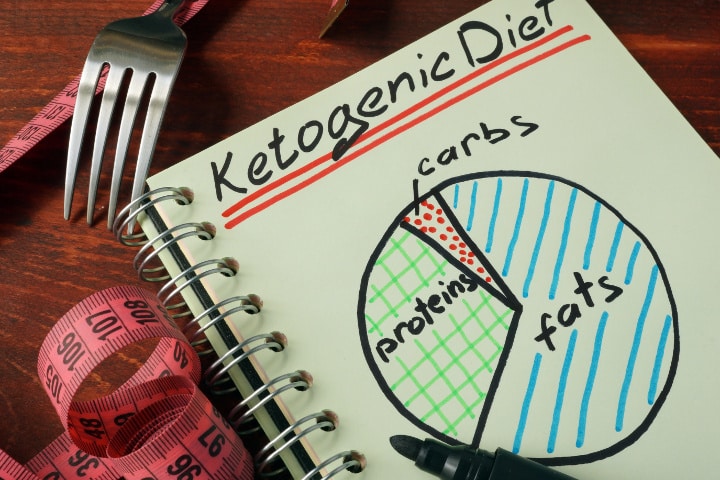 Whereas on a ketogenic diet, you’d get 100 calories from carbs, 400 from protein, and 1,500 calories from fat.
Whereas on a ketogenic diet, you’d get 100 calories from carbs, 400 from protein, and 1,500 calories from fat.
Understanding where your energy comes from and setting realistic goals for macronutrition is critical for your success on a keto diet.
So, how can you track daily macros and goals?
MyFitnessPal is a free, easy-to-use calorie counter and food journal app. Quickly log meals and save recipes you find online from your laptop or phone.
If you’re looking for more of a meal plan than a macro tracker, keto programs like the Fat Fueled diet plan from Healthful Pursuit make sticking to daily macro goals as easy as following the provided recipes and shopping lists.
What Can You Eat on a Low Carb High Fat Diet?
Speaking of meal plans and shopping lists, let’s talk food!
Low carb ketogenic diets naturally suppress your appetite and reduce cravings, which is why people tend to automatically eat fewer calories.
But where should those calories come from?
As a general rule, your diet plan should include foods from the following groups:
- Fats & oils.
- Low-starch vegetables.
- Dairy.
- Nuts & seeds.
- Protein. Not too much, though. Your protein intake should be about the same as it was on a standard, high carb diet.
Eating from these food groups can help you get the nutrients and minerals you need to thrive on a keto diet.
Fats & Oils
As the Low Carb High Fat name indicates, you’ll be eating lots of fat on a keto diet.
Most of your saturated fats will come from natural fats and oils.
These aren’t processed fats!
Stick to natural fats found in unprocessed meats (avoid cold cuts and sausage), eggs, and fatty fish or cheeses. And remember that many meats are high in protein, so you’ll need other sources of fat to avoid eating too much protein.
Some low carb fats and oils include:
- Animal fat (chicken fat, duck fat)
- Butter
- Coconut oil
- Olive oil
Low carb fats and oils to avoid:
- Refined fats and oils
- Processed meat (cold cuts, sausage)
Low-Starch Vegetables
Many of the vegetables that grow above ground are relatively low in carbs (less than 5 carbs per 100 grams).
And many of those carbs are coming from natural, non-digestible fiber.
Vegetables are also high in vitamins and minerals the body needs to stay healthy and fight disease.
Low carb veggies include:
- Leafy greens
- Cucumbers
- Broccoli
- Lettuce
- Asparagus
- Cauliflower
- Red, green, and yellow bell peppers
- Zucchini
- Kale
- Celery
- Avocados
High carb veggies to avoid:
- Potatoes
- Corn
- Peas
- Beets
- Carrots
- Beans & legumes
Dairy
High fat dairy is a great way to increase fat calories without getting too many sugars found in low fat or heavily processed dairy.
Stick to the following dairy products when eating keto:
- Butter
- High-fat yogurt (in moderation)
- Real whipping cream (combine with a handful of berries for a delicious dessert)
- Heavy cream (for cooking)
- Mascarpone, Stilton, Cheddar, and other high-fat cheeses
High carb dairy to avoid:
- Milk
- Processed whipping cream
- Coffee creamer (non-dairy cream substitutes)
Nuts & Seeds
Nuts and seeds are one of the most popular snacks on a keto diet. Pecan, macadamia nut, and brazil nut have so much healthy fat and few enough carbs (less than 5 carbs per 100 grams — about three handfuls) that it’s almost impossible to eat too many carbs while snacking on them.
Other nuts, like the cashew and pistachio, have 3–5 times as many carbs as a macadamia nut.
Great nuts to snack on during keto:
- Pecans
- Macadamia nuts
- Brazil nuts
- Flax seeds
- Pumpkin seeds
- Sesame seeds
- Sunflower seeds
Nuts and seeds to avoid:
- Cashews
- Pistachios
Protein
Incorporate moderate amounts of real-food protein sources into your diet. The higher the fat content, the better.
Because most protein sources also provide dietary fat, try to stick to grass-fed meat, wild-caught fish, and pastured eggs as they carry higher levels of omega-3 fatty acids.
Protein powder is ok in small amounts on a keto diet. But, because it’s so easily digested and absorbed, protein powder will cause a greater insulin reaction than whole-food protein sources.
Great protein sources on a keto diet include:
- Grass-fed meat
- Wild-caught, fatty fish
- Pastured chicken and eggs
- Macadamia nuts, pecans, and other low-carb nuts
Protein sources to avoid:
- Cold cuts
- Sausage
- All processed meats
- Pistachios, cashews, and other high-carb nuts
Condiments & Flavor Fillers
Condiments and sauces can make or break a meal. Thankfully, many of the most common condiments, sauces, and flavor enhancers are keto-friendly.
Keto-friendly condiments, sauces, flavor-enhancers include:
- Mayonnaise
- Mustard
- Pesto
- Bone broth
- Fermented foods
- Herbs & spices
- Lemon juice
- Cocoa powder
- Extra dark chocolate
Condiments to avoid:
- Artificial sweeteners
- High sugar jellies and jams
- Ranch dressing (don’t worry, there are keto-friendly alternatives)
Beverages
Keeping your drinks keto-friendly means avoiding natural and artificial sugars.
You can always reach for one of the following keto-friendly beverages:
- Water
- Coffee (black or with cream or coconut milk)
- Herbal tea
- Black or green tea
Drinks to avoid:
- Milk
- Alcohol (especially sugary mixed drinks)
- Fruit juice
- Soda
- Sugary drinks
Other Foods to Avoid on a Keto Diet
- All grains
- Processed food
- Refined fats and oils
- Foods with more than 5% carbs
Surprising Keto-Friendly Alternatives to Your Favorite Foods
Starting a new diet can be tough when you have to give up your favorite foods. Thankfully, keto-friendly alternatives exist for many of our favorite high-carb foods.
Keto Pasta. If you miss the taste and texture of pasta, keto-friendly noodles are just a few ingredients away. You can either pick up keto-friendly noodles at a specialty food store or make your own with this keto egg noodle recipe.
Keto Bread. Switching from burgers and sandwiches to lettuce wraps can be difficult at the start of a keto diet. Thankfully, one good keto bread recipe is all you need to reintroduce all your favorite bread-needy meals. Sandwiches? Hamburgers? French toast? Yup, yup, yup.
Keto Ranch Dressing. Not everyone likes ranch dressing. But, some people absolutely love it. With this homemade, keto-approved ranch recipe, you can have your ranch and eat it too.
Low Carb High Fat/Ketogenic Recipes
Cutting carbs doesn’t mean you can’t eat tasty, satisfying food.
Create a low carb, high fat menu you’ll love with these top keto recipes.
Breakfast: Avocado Breakfast Bowl
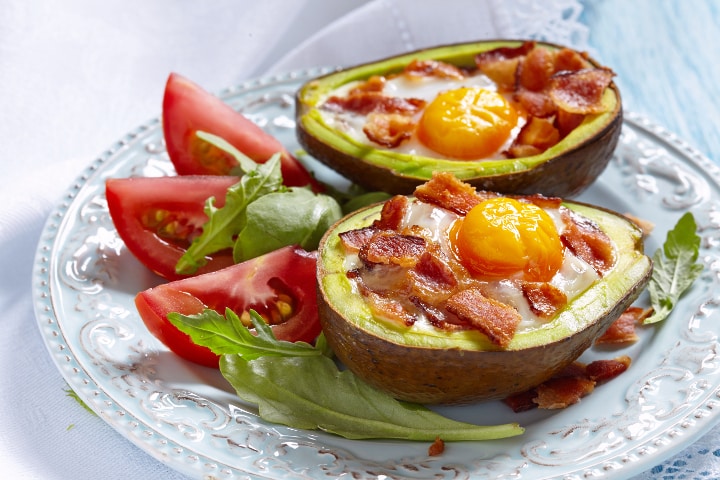
Recipe Source: https://www.perfectketo.com/perfect-keto-avocado-breakfast-bowl/
Prep Time: 5 mins
Cook Time: 15 mins
Servings: 1
Ingredients:
- 1 avocado, halved and the stone removed
- 1 T salted butter
- 3 large pastured eggs
- 3 rashers of bacon, cut into small pieces
- Pinch of salt and black pepper
Instructions:
Scoop out most of the avocado flesh, leaving about ½ inch around the outside.
Place a large saucepan on low heat and add the butter.
While the pan is heating and the butter is melting, add the 3 eggs and pinch of salt and pepper to the bowl and beat them.
Now add the bacon to one side of the saucepan (the one you’ve had on low heat) and let it start to fry.
After a few minutes, add the eggs from the bowl to the other side of the pan, and stir regularly as they scramble.
The eggs and bacon should both be done 5 minutes after the eggs are added to the pan. If you find you eggs are done a little before the bacon, remove the scrambled eggs from the pan and place them in a mixing bowl.
Mix the cooked bacon pieces and scrambled eggs in a bowl. Now spoon a helping of eggs and bacon into the avocado bowls and enjoy!
Lunch: Zucchini Noodle Shrimp Scampi
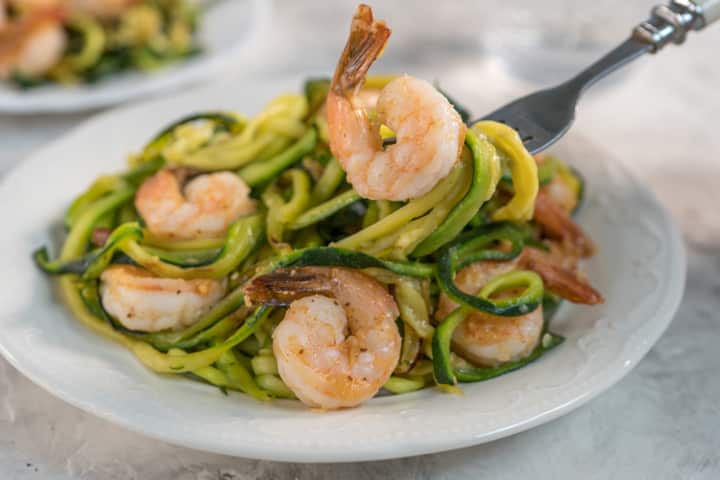
Recipe Source: https://www.lowcarbmaven.com/zucchini-noodle-shrimp-scampi/
Prep Time: 20 mins
Cook Time: 10 mins
Servings: 4
Ingredients:
- Shrimp Scampi
- 1 lb shrimp, shelled
- 2 T salted butter
- 3 cloves garlic chopped
- 1/4 cup lemon juice
- 1/4 cup dry white wine or chicken broth
- 1/4 teaspoon red pepper flakes
- 2 scallions, sliced (include the light green part, too)
- 1/4 cup parsley chopped (about one small handful)
- 2 T more salted butter
- Zucchini Noodles
- 1 1/2 pounds zucchini, spiralized into noodles
- 2 T salted butter
- Toss With the Rest
- 1/2 cup grated Parmesan cheese
- 4 slices bacon, crumbled
- 6 ounces cherry tomatoes, halved
Instructions:
Prep
Peel and devein the shrimp. You can do this the night before you cook.
Juice the lemon. Chop the garlic and parsley, halve the tomatoes, slice the scallions and crumble the bacon. Spiralize the zucchini — this can be done the night before.
Shrimp
Place a large saute pan over medium heat. When the pan is hot, add 2 T butter. As the butter melts, tilt the pan to make sure the whole bottom is coated. Add the garlic and saute until it begins to soften.
Add the shrimp to the pan and cook until the bottom half of the shrimp turns pink. Turn each shrimp over with a pair of tongs and add the red pepper flakes.
When the shrimp looks almost cooked through, add the lemon juice, then the wine. Cook about one more minute to let the liquid reduce.
Turn off the heat and add the remaining 2 T of butter, parsley, and scallions, stirring to mix the ingredients thoroughly. Salt and pepper to taste.
Move the shrimp scampi to a serving tray or bowl and use a foil tent to keep it hot while you make the zucchini noodles.
Zucchini
Place the same pan you used to make the shrimp back over medium heat. When it’s hot, add 2 T of butter and saute the zucchini until crisp and tender.
You can add 1–2 T of water or broth to get the zucchini steaming a little. Salt and pepper to taste.
Combine
Add the Parmesan cheese to the zucchini and toss. Now add the shrimp and sauce, bacon and tomatoes to the zucchini and toss.
Serve with lemon wedges, more cheese and red pepper flakes if desired.
Dinner: Paleo Beef & Broccoli Stir Fry
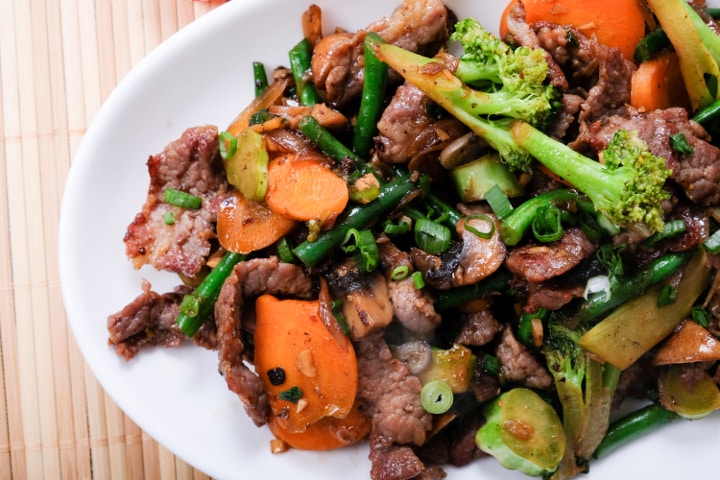
Recipe Source: https://iheartumami.com/paleo-beef-with-broccoli/
Prep Time: 15 mins
Cook Time: 10 mins
Servings: 4
Ingredients:
- Beef
- 1 lb beef (sirloin, skirt steak, boneless short ribs, etc.)
- 1 to 2 heads broccoli, break into florets
- 2 cloves garlic, minced
- 2 pieces thin sliced ginger, finely chopped
- Ghee or cooking fat of your choice
- Beef marinade
- 2 T coconut aminos
- 1/2 t coarse sea salt
- 1 T sesame oil
- 1/4 t black pepper
- 1 t arrowroot/sweet potato powder
- 1/4 t baking soda
- Sauce combo
- 2 T coconut aminos
- 1 T red boat fish sauce
- 2 t sesame oil
- 1/4 t black pepper
Instructions:
Combine the beef marinade ingredients in a small bowl and mix well.
Cut beef into ¼ inch slices. Marinate thin sliced beef with beef marinade. You can let the beef marinate for several hours or just while you prep the rest of the meal.
Combine the sauce combo ingredients. Mix and set aside.
Cook broccoli florets with 1–2 T water on the stovetop or microwave until it is tender but still crunchy. Set aside.
Heat a wok over medium heat with 1 ½ T ghee or other cooking fat. When the wok is hot, add garlic and ginger. Season with a small pinch of salt, and stir-fry until fragrant (about 10 secs).
Now turn up the heat to medium-high and add the marinated beef. Spread the beef evenly over the bottom of the saute pan and cook until the edges of the beef are slightly darkened and crispy. Flip the beef slices and repeat. This will give you savory beef with a slightly charred and crispy surface.
When the beef is ready, add the sauce combo you prepared earlier. Continue to stir-fry about 1 min.
Add the broccoli and leave the wok over medium-high heat for another 30 secs.
Toss everything to combine.
Dessert: Sugar Free Chocolate Truffles
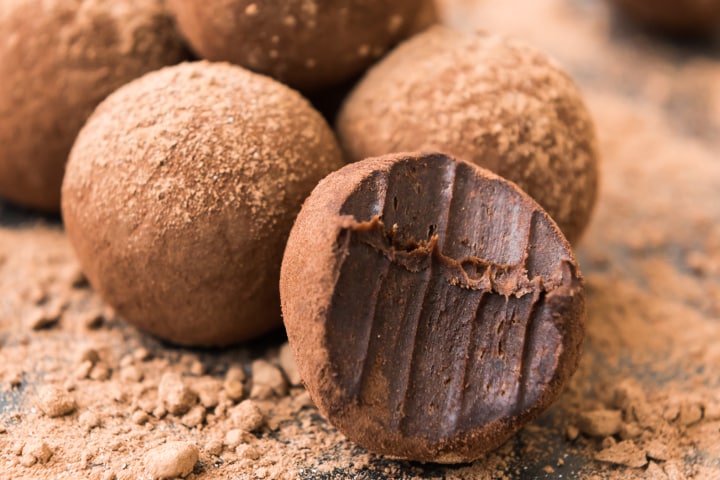
Recipe Source: https://www.lowcarbmaven.com/sugar-free-chocolate-truffles/
Prep Time: 10 mins
Cook Time: 6 mins
Servings: 22 truffles
Ingredients:
- 1 cup sugar-free chocolate chips
- 3/4 cup heavy cream
- 3 T butter
- 4 T Sukrin Melis (or Swerve Confectioners)
- 2 t brandy
- 1/4 t vanilla extract
Instructions:
Put the sugar free chocolate chips into a medium-sized, heat resistant glass bowl.
Place the heavy cream, butter, and 4 tablespoons of sweetener into a small pot. Put the pot over medium heat until small bubbles form around the sides and the cream starts to steam. Stir to dissolve the sweetener.
Now, pour the hot cream over the chocolate chips and let it sit for 5 minutes. After 5 minutes, stir gently with a whisk until the mixture is smooth and fully incorporated. Add the vanilla and brandy and stir.
Let cool, then cover and refrigerate several hours until firm or over night.
After the mixture cools, put a piece of waxed paper on your work surface. Scoop the firm chocolate ganache from the bowl with a small dinner spoon or a melon baller and place onto the waxed paper.
Continue until the ganache is gone.
If the ganache is too firm, let it warm up outside of the fridge for 30 to 60 minutes before scooping. If your truffles become too warm and soft to shape, refrigerate them again until they are firm enough to handle.
Roll each portion of ganache into round “truffles.” You can weigh each truffle to make sure they’re the same size (about 15 g), but this isn’t necessary.
Once shaped into balls, you can roll the truffles in chopped nuts, grated chocolate, sesame seeds, coconut, sprinkles, crushed freeze-dried fruit, matcha powder, or unsweetened cocoa powder.
Store the truffles in an airtight container in the fridge, but serve and enjoy closer to room temperature.
A quick search online will reveal hundreds of keto-friendly recipes for every meal and occasion.
Knowing how to combine those meals to balance your macros over the course of a day, week, and month, however, is more difficult.
For those of us who don’t have the time, energy, or information we need to create our own full keto menu, ready-made diet plans offer the perfect solution.
Low Carb High Fat/Ketogenic Diet Plan
Starting a keto diet without a clear meal plan is a recipe for disaster.
In its simplest form, a keto diet plan tells you what to eat and roughly when to eat it. It offers recipes and shopping lists and a nutritious menu for every day of the week.
But a good keto diet plan is so much more than just meal planning and counting macros.
It doesn’t just help you control fat intake, but the type of fat.
You won’t just receive recipes, you’ll learn how to make your own recipes and meal plans to suit your taste and dietary needs.
A keto diet plan is really a keto lifestyle guide, sharing the expertise of every nutritionist, doctor, dietician, and fitness professional who worked on it.
A great diet plan will include:
- Macro tracking
- Keto recipes
- Meal plans
- Shopping lists
- Food substitutes
- Fast keto meal and snack options
- Options for when you need to carbo-load or replenish glycogen stores
- Tips and tricks for how to adapt recipes and build your own
How to Find the Right Diet Plan
If you aren’t a nutritionist or doctor, your best bet when first starting a keto diet is to stick to a pre-made diet plan.
But with so many people selling keto cookbooks, diet plans, and fitness plans, how can you find the right program for you?
Start by finding a brand you trust.
When you come across a new brand, take some time to read through their website. Are they answering questions you have or is every page a sales page? Essentially, are they talking to you or your wallet?
Check that the plan has the information you need.
Many of the diet plans you can find online are more like guidelines — a few recipes, a food list, and 1-week calendar showing how you could combine options and build a menu. While this makes getting started easy, it can leave beginners at a loss for how to maintain their momentum.
If you’re new to keto, or if you’re struggling to get the results you expected, you might need a more extensive keto program, rather than a simple meal plan.
Consider whether the diet plan offers tips for food allergies or vegan diets.
Make sure the plan is big enough.
While some meal plans cover a month or more, others only provide recipes and shopping lists for just a few days.
Being able to plan your own keto meals and menu is satisfying, but don’t try to do too much too early, especially while you’re still becoming keto-adapted.
A ready-made meal plan makes it easy to stick to macro goals, and it can give you dozens of recipes and meal ideas you can use to build your own keto menu.
Before you buy or subscribe to any meal plan, make sure you’re getting the menu you expect.
Test the recipes.
You don’t have to test every recipe on a company’s website, but it’s worth making a few and seeing if you like them.
You’ll only get a small taste of what the company can offer, but it’s easier to commit to a diet plan when you already know you love one of the recipes.
Test the actual diet plan.
If you still aren’t sure what diet plan will work for you, why not take it for a test drive?
Look for a free trial or sample and put the plan into action for one or two days.
The first few days of a diet can be the toughest, so pay more attention to what you like about the plans you test. That way, even if you choose not to continue the plan, you’ll know what to look for in the next one.
1-Week Sample Keto Diet Plan from Healthful Pursuit
The following 1-week simplified sample diet plan was created using meals and suggestions from the Fat Fueled Program by Healthful Pursuit.
Day 1:
| Breakfast | Lunch | Dinner | Snack (optional) | Carb-up Option |
| Fudge muffins | Lettuce cups with egg salad | Mashed “potatoes” with chicken | Strawberry italian lemonade | Sweet potato chipotle bowl |
Day 2:
| Breakfast | Lunch | Dinner | Snack (optional) | Carb-up Option |
| Cheddar drop biscuits | Green chicken curry | Tomato and cucumber salad with your choice of meat | Keto fudge shake | Berry bowl with maple syrup and coconut |
Day 3:
| Breakfast | Lunch | Dinner | Snack (optional) | Carb-up Option |
| Bacon and eggs | Meatball miniwiches | Roasted rutabaga with dijon chicken | Cacao butter chips | Curry bowl with rice vermicelli noodles |
Day 4:
| Breakfast | Lunch | Dinner | Snack (optional) | Carb-up Option |
| Keto granola bars | Salad with avocado, shrimp, and lemon juice | Keto spaghetti | Celery with nut butter | Shredded pork with herbed rice |
Day 5:
| Breakfast | Lunch | Dinner | Snack (optional) | Carb-up Option |
| Sliced avocado bacon wraps | Soft tortilla tacos | Hamburgers (naked or with lettuce wrap) with guacamole and side salad | Dark chocolate | Chili shrimp and spicy dip |
Day 6:
| Breakfast | Lunch | Dinner | Snack (optional) | Carb-up Option |
| Spicy asian greens with fried eggs | Spinach salad with herb crackers | Chicken fettuccine alfredo with shirataki noodles | Parmesan crisps | Walnut chicken |
Day 7:
| Breakfast | Lunch | Dinner | Snack (optional) | Carb-up Option |
| Coconut milk smoothie | Ground beef with parmesan crisps and romaine | Shrimp curry with coconut milk and cauliflower rice | Sunflower seeds | Bombay sloppy joes |
Food Substitutes
If one of the meal options in the plan includes ingredients you don’t like or can’t have, look for a substitute in the keto food list included in the diet plan.
Source: Fat Fueled Program (Healthful Pursuits)
Tracking Meals and Macros
Even the most detailed diet plan can’t account for every possible change to its recipes and recommended portion sizes. But a good diet plan should include a way for you to track meals and macros.
Other Resources
Switching to a keto diet isn’t easy for many people. It can take several weeks to become keto-adapted, and you may experience a few temporary side effects as your body enters ketosis.
Combining a keto diet with other dietary regimens can add to the complexity of meal preparation, but it can be done. Search for guides that will help you go keto while also abiding by vegetarian diets, avoiding various food allergens, or accommodating religious restrictions. For instance, there are excellent resources for recipes on how to eat both keto and kosher.
If the diet plan you’re using doesn’t provide the resources and support you need to be successful, you may need to supplement the plan with other resources (like MyFitnessPal) or even find a new, more detailed diet plan like the Fat Fueled Program from Healthful Pursuits.
Side Effects of Keto
The ketogenic diet is a powerhouse for weight loss and offers a clear path to better health for many people who have struggled with to get results with other diets.
While your body adapts to your new diet, however, you may experience a number of side effects.
Don’t worry — these are common. And, once you know how to identify these issues, you can take steps to prevent them.
While the symptoms you experience may vary, side effects of the keto diet are typically related to one of three factors:
- Low blood sugar
- Hypothalamus, Pituitary, and Adrenal (HPA) dysfunction
- Mineral and electrolyte deficiencies
Hypoglycemia (Low Blood Sugar)
Low blood sugar is common in the first few weeks of a ketogenic diet. Your body is still learning how to burn fat for energy, and this can cause a few undesirable side effects as you start a low carb, high fat diet.
Keto flu is the onset of flu-like symptoms at the beginning of a ketogenic diet. If you’re experiencing headaches, fatigue, nausea, and runny nose, you may be hypoglycemic.
Intense food cravings can spell disaster for any diet. No matter how strong your willpower may be, some cravings feel like a matter of life and death. When your blood sugar lowers substantially, your body can go into panic mode. Even though you know you are getting plenty of healthy food and all the nutrients you need, your body thinks it’s starving and triggers intense food cravings — typically for high sugar, high carb foods that can quickly raise blood sugar levels.
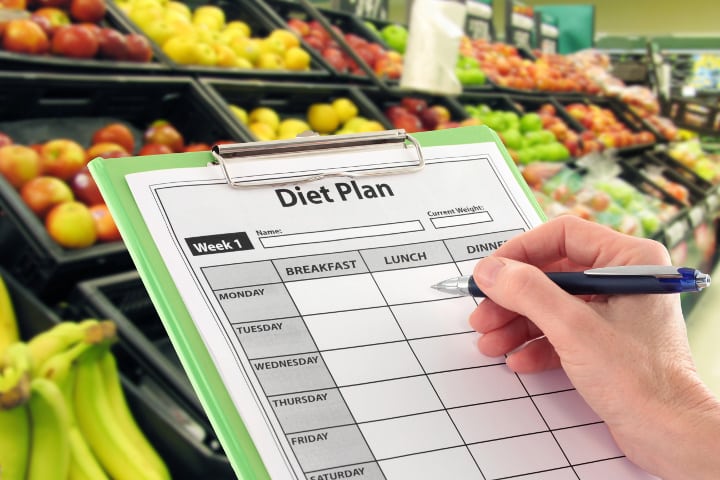 You may become disoriented or exhausted for a short period when starting a ketogenic diet. Until your body learns to efficiently burn fat for energy, you may be operating on fewer calories of fuel regardless of how much fat you eat.
You may become disoriented or exhausted for a short period when starting a ketogenic diet. Until your body learns to efficiently burn fat for energy, you may be operating on fewer calories of fuel regardless of how much fat you eat.
Low blood sugar during the first few weeks of a ketogenic diet can also lead to reduced physical strength and performance. Don’t worry, the change is only temporary as your muscles learn to use fat for fuel instead of sugars from carbs.
Don’t worry, your body is still adapting to the keto diet, and symptoms should pass within the first few weeks. Fortunately, there are a few simple strategies you can use to quickly mitigate low blood sugar when going keto.
Treating and Preventing Hypoglycemia
- Eat every few hours. Keep your body happy and your blood sugar even with keto-friendly snacks between meals.
- Get plenty of minerals. Try drinking mineral water and eating mineral-rich foods, like nuts, lentils, leafy greens, and fish.
- Add supplements. If you are struggling to respond to symptoms of hypoglycemia with the above tips, you may benefit from adding a keto supplement to your daily routine. *Learn more about keto supplements.
HPA Axis Dysfunction (Stress & Cortisol Levels)
The hypothalamus, pituitary, and adrenal glands make up the HPA axis. Irregularities in how these three glands function can trigger a host of symptoms, including hypoglycemia and a cycle of low blood sugar.
When the adrenals aren’t functioning properly, they can release extra cortisol — a stress hormone that interacts with almost every cell in the body.
Fluctuations in cortisol can cause sleep problems by interfering with melatonin. Melatonin is the hormone responsible for regulating the body’s circadian rhythm (wake/sleep cycle).
Sustained high cortisol levels can also cause heart palpitations. As the body becomes resistant to cortisol, it produces more adrenaline to compensate, which can create irregular heart rhythms.
Even knowing that these symptoms are common when adapting to a keto diet, they can be frustrating and frightening.
Promoting Regular HPA Axis Function
- Manage your blood sugar. Cortisol can wreak havoc on your body’s natural rhythm, and hypoglycemia is one of the primary causes of irregular cortisol production.
- Add supplements. If your blood sugar isn’t low but you’re still experiencing irregular cortisol levels and the symptoms of HPA axis dysfunction, you may benefit from adding a keto supplement to your daily routine. *Click here to learn more about keto supplements.
Nutritional Deficiencies
Changing to a new diet can be difficult. Forgetting one piece of the pie (so to speak) can leave you with a deficiency in your nutrition. Whether you aren’t getting enough water, minerals, electrolytes, or vitamins, the symptoms can be unpleasant.
Frequent urination, diarrhea, and constipation are all common signs of a nutritional imbalance or a change in gut bacteria.
Muscle cramps are also more common when you’re dehydrated or when your body is expelling minerals faster than you are replacing them.
Avoiding Deficiencies During Ketosis
- Stay hydrated. Drink plenty of hydrating beverages to help flush out toxins and replenish fluids from any increased urination you may experience while becoming keto-adapted.
- Eat your greens and other mineral rich foods. When you’re so focused on eating fatty foods, it’s all too easy to forget about eating greens. And, some foods just don’t give your body the minerals it needs.
- Pay attention to how food affects you. Some foods, like eggs and cheeses, are more conducive to constipation, and it may help to reduce these foods until after you’re keto-adapted. If you’re following a meal plan, identifying and replacing problem foods will be easy.
- Follow a keto diet plan. A ketogenic diet gives you tons of flexibility in what you eat. But to ensure you become keto-adapted as quickly as possible, stick to a pre-made diet plan when starting out. You’ll know you’re getting the total calories and balance of macronutrients you need, and you can always introduce your own recipes and meal plans when your body is keto-adapted and you’re more familiar with eating a low carb, high fat diet.
Dealing with Keto Breath
We mentioned earlier that keto breath as one of the signs your body is in ketosis.
While you’re probably excited about becoming keto-adapted, dealing with keto breath during the transition can be a nuisance.
The following strategies can help you fight back against bad keto breath.
- Stay hydrated. One of the biggest drivers of bad keto breath is dry mouth.
- Brush your teeth more often & use natural mouthwash. Good oral hygiene is your first line of defense against keto breath.
- Use a natural breath freshener. Chew on rosemary, mint, or parsley between brushes (just make sure you don’t get any stuck between your teeth!).
And try not to worry. Keto breath is typically only an issue during the initial adaptation phase.
Other Side Effects While Transitioning to Keto
There are a few less common side effects you may experience when making the transition to a ketogenic diet.
In some cases you may develop keto rash, an itch on your chest, torso, back or neck. While the rash can be uncomfortable, there’s no reason to be alarmed. There are natural solutions to the itching associated with keto rash. And if the rash becomes severe enough to interfere with your sleep or daily life, your doctor should be able to provide a balm or lotion to get you past the temporary discomfort.
To reduce the chances of keto rash and other less common side effects, be sure to eat full meals and follow a clear keto diet plan like the one we demonstrated earlier.
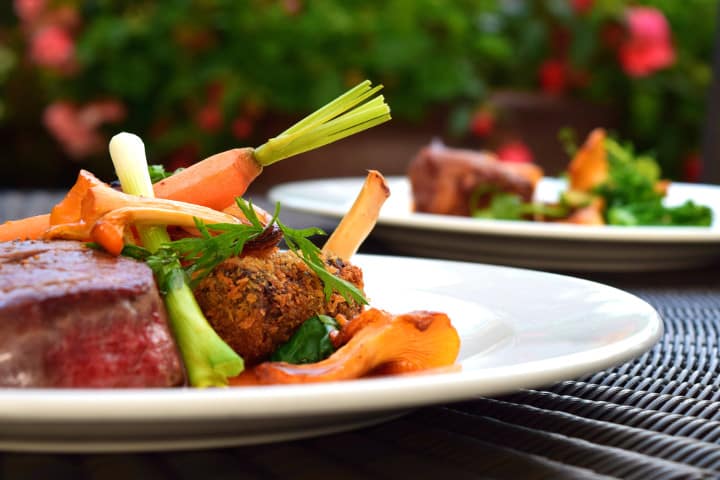
Common Questions About the Low Carb High Fat Diet
Ok. We’ve talked about what keto is, how it works, what happens to your body, what you can eat and how to find a great keto diet plan.
But, you may still have questions about eating a low carb, high fat diet. While we know we can’t answer every question you may have, we’ll try to answer the most common questions we hear about the LCHF diet.
“Is the low carb, ketogenic diet just another fad?”
While the keto diet has the popularity and celebrity name recognition of many fad diets, it doesn’t fit the bill for a few reasons.
First, it continues to gain more support as new studies are completed, and the evidence seems to show that the keto diet isn’t just another crash weight loss diet. In addition to supporting weight loss, the keto diet has been shown to lower insulin levels, reduce blood sugar, lower blood pressure, improve levels of good cholesterol, reduce levels of bad cholesterol, increase metabolic flexibility, and more.
“Don’t you need carbs to function?”
The body’s default energy source is the glucose we get from carbs, but we’re just as well suited to run on fuel from fat. While you should eat enough carbs to keep emergency glycogen levels full, many professional athletes have been able to improve their performance and overcome training plateaus eating just 20–30 grams of carbs a day.
“What are some ways I can add fat to my diet?”
Choose fattier cuts of meat. Cook vegetables in butter instead of steaming them. Snack on handfuls of macadamia nuts and high-fat cheeses. Add bacon to your snacks and meals.
When cooking, use full-fat ingredients. If you don’t have your own recipes, find a handful of high-fat recipes you love and that you can use for breakfast, lunch, or dinner.
“How can I save money on a keto diet?”
One of the biggest costs in any diet is paying for the label. If you’re only buying foods that say, “low carb” or “keto” on them, you’re probably spending more than you need to.
If the diet plan you’re using doesn’t offer low-cost keto options, spend an afternoon Googling budget keto foods and looking at labels in your local grocery store.
Once you know what options are low carb, high fat, you can look for deals and quickly find lower cost alternatives.
If you have the fridge, freezer, and pantry space, buy in bulk when you find a good deal.
“Can I have cheat meals or days and still be keto-adapted?”
The more carbs you eat, the harder it will be to get and stay keto-adapted.
But any carb reduction can be a good thing. And, as we noted earlier in the article, many athletes use targeted or cyclical keto diets as a way to get the carbs they need without giving up on being ketogenic.
“Why aren’t I seeing the results I expected?”
One of the most obvious reasons you won’t see results on the LCHF diet is that you’re eating too many carbs or proteins.
If you cut your carbs to 100 grams, try dropping them to 50 grams. If your protein intake increased when you went low carb, scale back to just 15–20 percent of your daily calories from protein.
Most importantly, make sure to track your macros. If you don’t know what you’re eating and where your calories are coming from, you won’t be able to get the consistent results you want.
“Are there any supplements that will help me become keto-adapted?”
There are a few keto supplements, like MCT oil and exogenous ketone supplements, that can help raise ketone levels. These supplements won’t help you lose weight, but they can help your body get used to burning fat as fuel so you become keto-adapted.
“How often should I test ketone levels?”
Depending on your method of ketone testing (urine, blood, or breath), you may test as little as once a day and up to every 3–4 hours.
Rather than testing as often as possible, try to schedule one or two set times to test every day or two so you can control the settings and get more accurate results.
Tips to Get the Most Out of Keto
Getting the most out of the ketogenic diet starts with knowing how the diet works and what nutrients you need to keep your body healthy and fully fueled.
Remember that the Low Carb High Fat diet is a lifestyle change, not a crash weight loss diet. You’re cutting carbs, not calories.
Eat about 50 grams of carbs per day, with roughly 20–30 of those coming from natural, non-digestible fiber.
Keep protein levels steady. The goal is to become fat-adapted, and your body will turn to protein for fuel if you increase protein beyond 15–20 percent of your daily calories.
Don’t be scared of fat. Put extra cheese on your burger. Cook with butter. Use full fat ingredients. The only fats you still need to avoid are trans fats and refined fats.
Determine your daily macro goals and have a plan for how you’re going to track macros. Having a clear plan is one of the surest ways to be successful on a keto diet.
Speaking of having a clear plan, consider purchasing or subscribing to a diet plan as an easy way to get the most out of your first month on a ketogenic diet. You’ll get recipes, shopping lists, and tons of resources to help you stay on track and troubleshoot any potential challenges.
This wouldn’t be an article about dieting if we didn’t mention exercise. Regular exercise will help your body become fat-adapted faster than a keto diet could alone.
If you aren’t getting the results you want, consider keto supplements as a way to help kick-start ketosis.
Finally, the best way to get the most out of a keto diet is to take the first step. Talk to your doctor, look up diet plans and keto recipes, plan a shopping list, and enjoy the new, healthier you.

